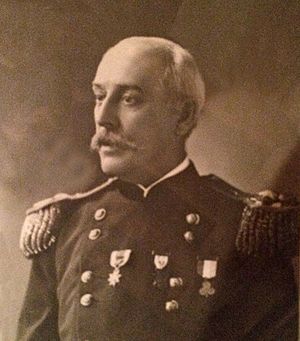Marshall I. Ludington facts for kids
Quick facts for kids
Marshall I. Ludington
|
|
|---|---|

Ludington as Quartermaster General of the Army, circa 1900
|
|
| Born | April 4, 1839 Somerset Township, Somerset County, Pennsylvania, US |
| Died | July 26, 1919 (aged 80) Skaneateles, New York, US |
| Buried | |
| Allegiance | |
| Service/ |
|
| Years of service | 1862–1903 |
| Rank | |
| Unit | U.S. Army Quartermaster Corps |
| Commands held | Philadelphia Quartermaster Depot San Francisco Quartermaster Depot New York City Quartermaster Depot Quartermaster General of the United States Army |
| Battles/wars | American Civil War American Indian Wars Spanish–American War |
| Signature | |
Marshall Independence Ludington (born July 4, 1839 – died July 26, 1919) was a dedicated officer in the United States Army. He served in the American Civil War and later became a brigadier general. This happened when he was the Quartermaster General of the United States Army during the Spanish–American War. He was promoted to major general just before he retired in 1903.
Contents
Early Life
Marshall I. Ludington was born in Somerset Township, Somerset County, Pennsylvania. His birthday was July 4, 1839, which is why his middle name was "Independence." He grew up in Somerset and Uniontown. He went to local schools and later studied at Madison College in Uniontown.
Serving in the Civil War
When the American Civil War began, Ludington joined the army in 1862. He became a captain and worked as an assistant quartermaster. A quartermaster is like a manager who makes sure soldiers have all their supplies. He was part of the Army of the Potomac.
Ludington helped supply troops in major battles. These included Fredericksburg, Chancellorsville, and Gettysburg. He also served during the Battle of the Wilderness and the start of the Siege of Petersburg. By the end of the war in 1865, he was in charge of supplies for a whole division. Because he did such a great job, he received special promotions. He was recognized as a major, lieutenant colonel, colonel, and brigadier general in the volunteer army.
After the Civil War
After the Civil War, Ludington stayed in the army. He worked to get rid of extra equipment and buildings that the army no longer needed. In 1867, he became a major in the quartermaster corps. He was sent to New Mexico for three years, where he was the chief quartermaster.
From 1870 to 1875, he worked at the main Quartermaster General's office. Then, he moved to Omaha, Nebraska, to be the chief quartermaster for the Department of the Platte. He stayed there until 1883. After a trip to Europe, he worked in the Quartermaster General's office again. He then became the chief quartermaster at the Philadelphia Quartermaster Depot until 1889. Later, he worked at the San Francisco Quartermaster Depot.
In 1890, Ludington was promoted to colonel. He became an Assistant Quartermaster General for the army. He also served as chief quartermaster in Chicago and later in New York City.
The Spanish-American War
In February 1898, Ludington became a brigadier general. He was put in charge of the entire Quartermaster department. This happened just 12 days before the USS Maine sank in Havana. This event led to the start of the Spanish–American War.
The army was not ready for a big war overseas. Ludington quickly told his teams to make more weapons and buy more clothes and tents. Once war was declared, his department worked hard. They had to supply and equip many new volunteer soldiers and the regular army.
Even with challenges like strict rules and not enough staff, Ludington's department got a lot of supplies ready. They did this very quickly in the spring and summer of 1898. Some people criticized the supply efforts during the war. President William McKinley asked a group to investigate. They found that the army was generally unprepared before the war. They said many problems came from the army being too small and not having enough trained officers.
Later Career and Retirement
After the war, the army grew bigger. Ludington helped build and fix barracks and storage buildings. These were needed in places like Cuba, Puerto Rico, and the Philippines. He also helped create new clothing and equipment for hot, tropical places.
Ludington also started the Army Transport Service. This service helped move troops and supplies smoothly. In 1901, he traveled to inspect U.S. forces in China, Japan, the Philippines, and Hawaii. On April 12, 1903, he was promoted to major general. This was to recognize his excellent service over more than 40 years.
Ludington retired the very next day. He then lived in Skaneateles, New York, his wife's hometown. He was a member of several military groups. He was also president of the II Corps Veterans Association in 1898.
Marshall Ludington passed away in Skaneateles on July 26, 1919. His funeral was held in Washington, DC. He was buried at Arlington National Cemetery.
Family and Legacy
In 1871, Ludington married Harriet Marvin. They were married until she died in 1910. They did not have any children.
An army ship, the U.S. Army Transport Ludington, was named after him. The army bought it in 1931. It was used during World War II to carry supplies and soldiers' belongings. The USAT Ludington was taken apart in 1947.

